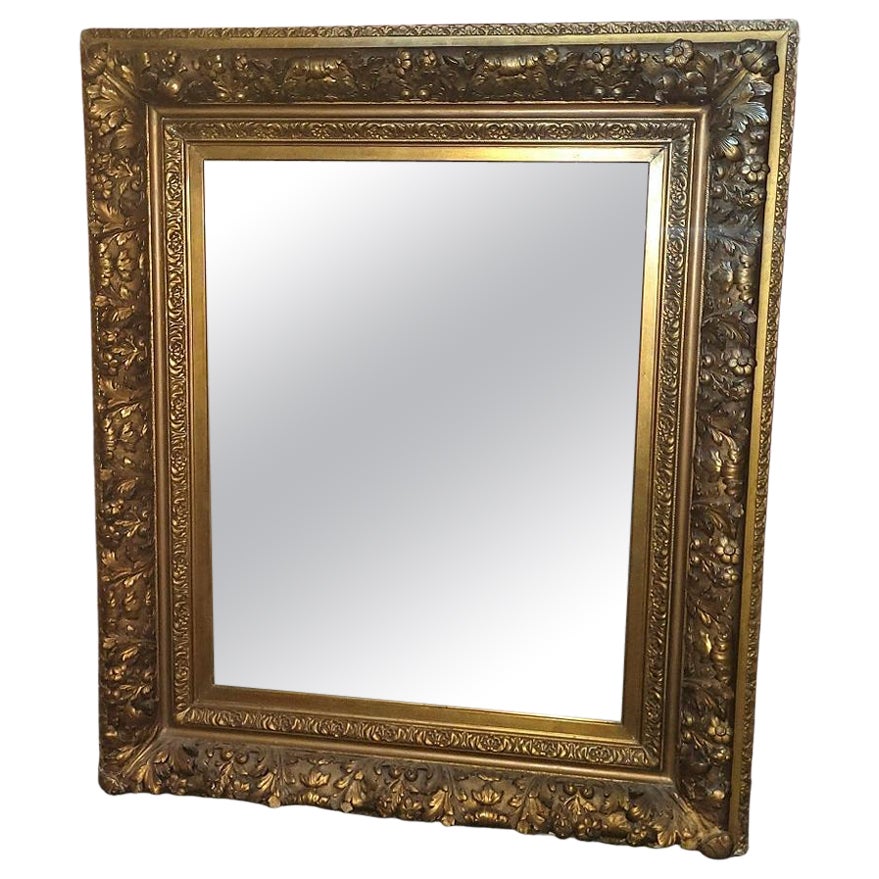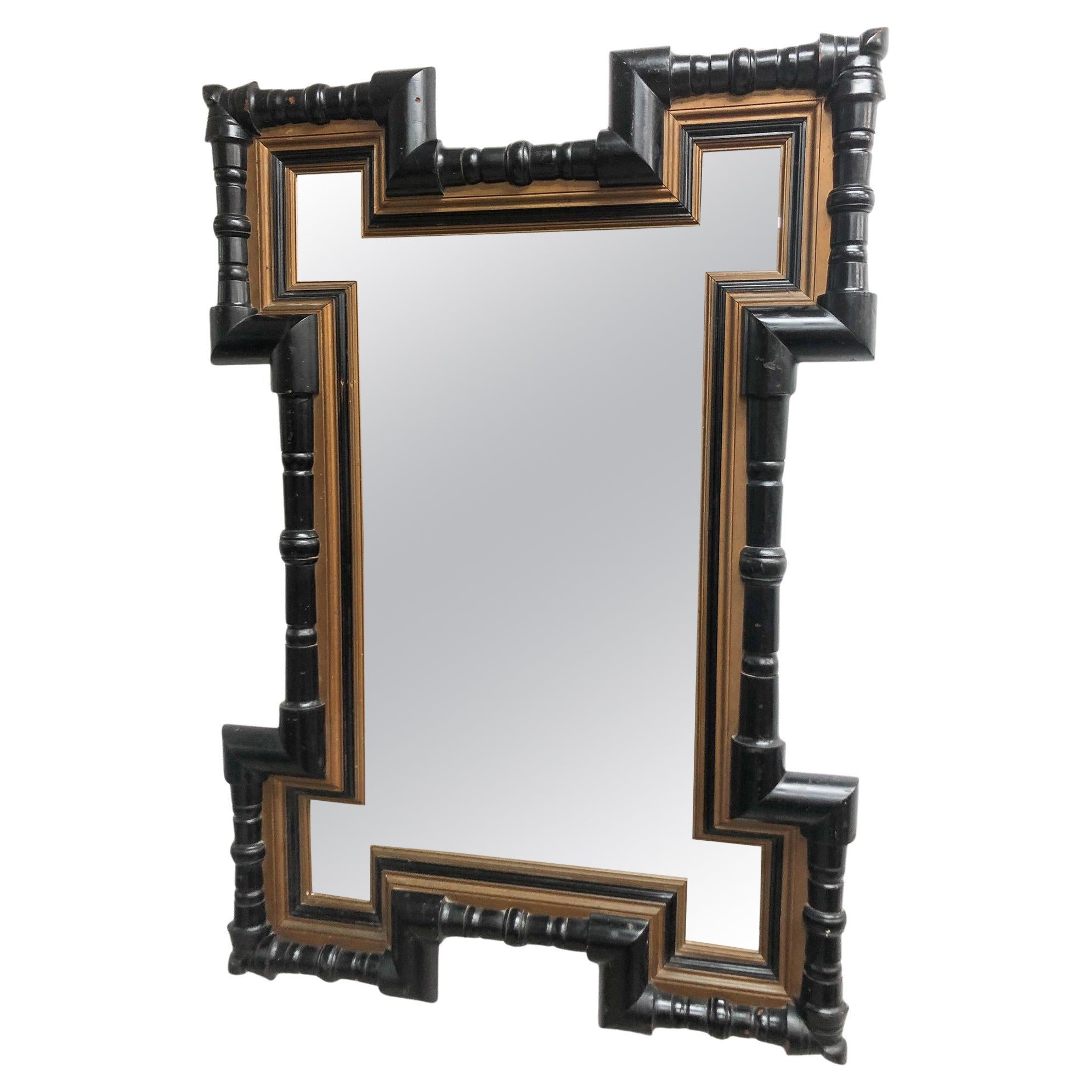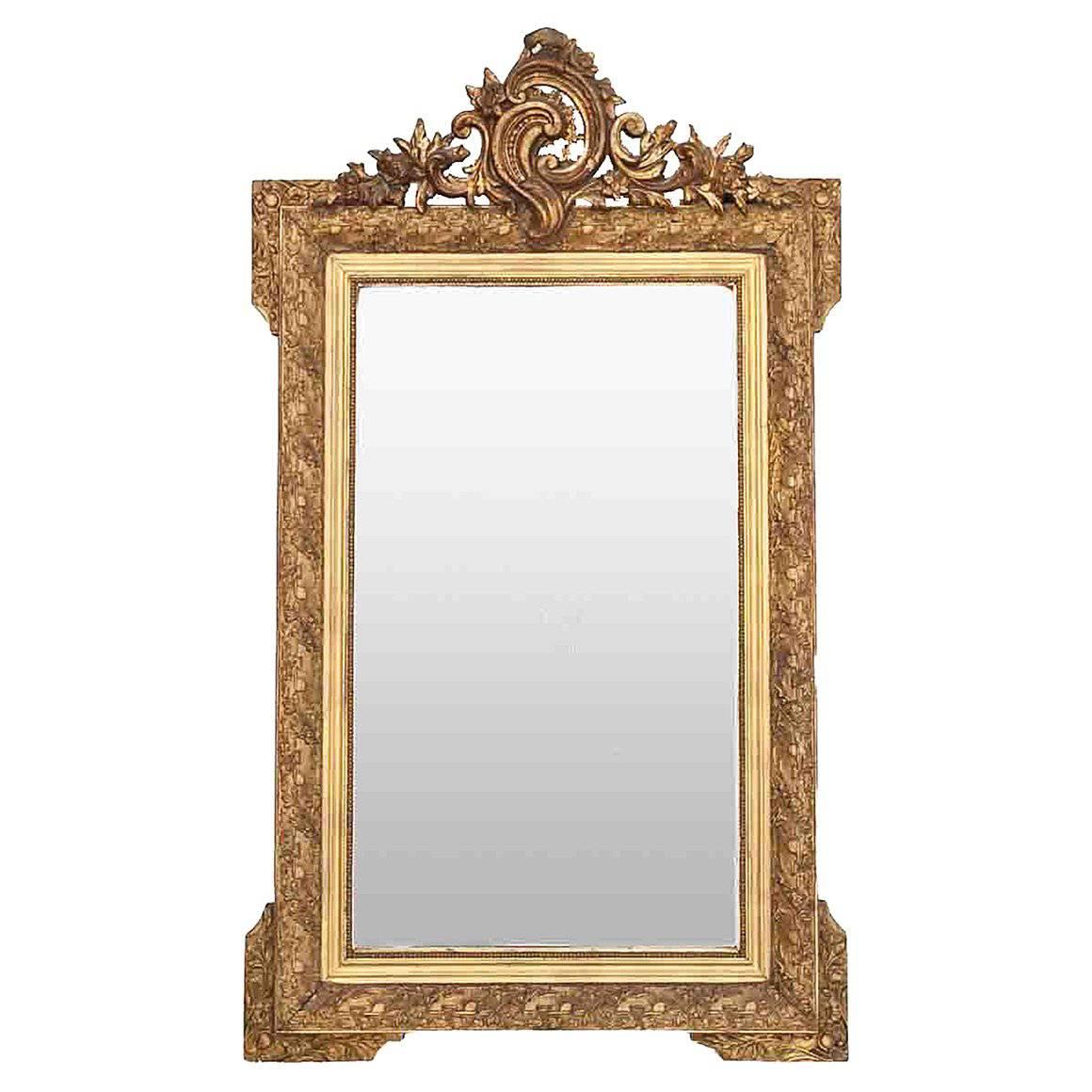Items Similar to 19th Century English Baroque Gilt Floral Wall Mirror
Want more images or videos?
Request additional images or videos from the seller
1 of 11
19th Century English Baroque Gilt Floral Wall Mirror
About the Item
PRESENTING A LOVELY 19 century English Baroque Gilt Floral Wall Mirror.
English, circa 1840.
In classic ‘Baroque’ style with scrolling acanthus and vines in very ornate design and detail. Made of giltwood, pine, oak and gesso.
Probably originally a frame for a painting, but mirror inserted instead.
Nice medium size, suitable for multiple uses and placement.
This is a high quality and rare, period mirror, in great condition for it’s age.
The mirror glass is a late 20C replacement, as unlike the frame, it does not have the signs of age with pithing to the mirror backing that one would expect with a period mirror. Also, the rear cardboard backing indicates a later replacement. This is not unusual, as these are functional pieces and the clarity of the mirror glass is important for daily use. Almost every period mirror has it’s glass replaced.
It is a ‘SUPER’ match for the Large/Monumental Early 19C English Baroque Floral Wall Mirror also in our Inventory and posted separately.
- Dimensions:Height: 24.25 in (61.6 cm)Width: 32.5 in (82.55 cm)Depth: 3 in (7.62 cm)
- Style:Baroque (Of the Period)
- Materials and Techniques:
- Place of Origin:
- Period:
- Date of Manufacture:1840
- Condition:Repaired: Some minor repairs to 2 corners but not significant. Wear consistent with age and use. Minor losses. Minor structural damages. Minor fading. Very good original condition. Some minor repairs on the corners/edges, but not noticeable. Mirror glass a replacement.
- Seller Location:Dallas, TX
- Reference Number:1stDibs: LU3978134221002
About the Seller
4.9
Gold Seller
These expertly vetted sellers are highly rated and consistently exceed customer expectations.
Established in 2015
1stDibs seller since 2018
349 sales on 1stDibs
Typical response time: <1 hour
- ShippingRetrieving quote...Ships From: Dallas, TX
- Return PolicyA return for this item may be initiated within 7 days of delivery.
More From This SellerView All
- Early 19C Large English Baroque Gilt Floral Wall MirrorLocated in Dallas, TXPRESENTING AN OUTSTANDING AND MONUMENTAL Early 19C Large English Baroque Gilt Floral Wall Mirror. English, circa 1810-20. In classic ‘Baroque’ style with scrolling acanthus and...Category
Antique Early 19th Century English Baroque Wall Mirrors
MaterialsGold Leaf
- 19th Century American Ebony Mirror with Bevelled GlassLocated in Dallas, TXPRESENTING A STUNNING mid to late 19th Century American Ebony Mirror with Beveled Glass. From circa 1860 -1880. This beautiful mirror is made of a deep/thick ebony veneer, over a s...Category
Antique Mid-19th Century American American Classical Wall Mirrors
MaterialsMirror, Ebony, Oak
- 19th Century English Burl Walnut Sutherland TableLocated in Dallas, TXLate 19th century English drop-leaf table from the Mid-Victorian Era. Made of gorgeous yellowish-brown walnut with a fantastic burl walnut table top. The patina on the top is simply glorious!! The table was made circa 1850-60. It sits on beautifully turned fluted legs with the porcelain and brass casters. Two of the legs swing inwards and outwards to extend the 2 leaves of the table. Fully extended the table has a fabulous curved and indented edge, in an oval shape on both ends. The center column is beautifully turned and fluted. The 2 side columns are again beautifully turned and fluted and end with 2 extending scrolling supports that end in turned bulbous twin feet. This is a high quality item and highly desirable! Antique Sutherland Tables...Category
Antique Mid-19th Century English High Victorian Side Tables
MaterialsWalnut, Burl
- Early 19th Century English Regency Sofa TableLocated in Dallas, TXPresenting a stunning early 19th century English Regency sofa table. Made from flamed mahogany, circa 1810-20. Drop leaves on either s...Category
Antique Early 19th Century English Regency Sofa Tables
MaterialsBrass
- Rare 19th Century English Eclipse Patented Telescopic DeskLocated in Dallas, TXPresenting an exceptionally rare 19th century English eclipse patented telescopic desk. Made of oak in the Rococo style in Great Britain, circa 1880. Fully marked as “The Eclipse” ...Category
Antique Late 19th Century English Late Victorian Desks
MaterialsBrass
- Rare 19th Century English Tunbridgeware Hair Pin or SlideLocated in Dallas, TXPresenting an absolutely gorgeous and extremely unique and rare 19th century British Tunbridgeware hair pin/bobbin or slide. This slide is unlike any of it’s kind we have seen before…. it is a very rare survivor ! From circa 1860–1880. Made of walnut with gorgeous marquetry inlay on the entirety of the front with classic Tunbridgeware micro-mosaic all over the front. The rear is walnut. The marquetry inlay appears to be various different woods, namely, maple, walnut and satinwood. Would have been worn in a Lady’s hair bun with the micro-mosaic facing forward. This would have belonged to a very elegant lady in the mid to late 19th century. Tunbridge ware is a form of decoratively inlaid woodwork, typically in the form of boxes, that is characteristic of Tonbridge and the spa town of Royal Tunbridge Wells in Kent in the 18th and 19th centuries. The decoration typically consists of a mosaic of many very small pieces of different coloured woods that form a pictorial vignette. Shaped rods and slivers of wood were first carefully glued together, then cut into many thin slices of identical pictorial veneer with a fine saw. Elaborately striped and feathered bandings for framing were pre-formed in a similar fashion. There is a collection of Tunbridge ware in the Tunbridge Wells Museum and Art Gallery in Tunbridge Wells. The famous makers of Tunbridge ware were in the Tunbridge Wells area of Kent; their most notable work was from circa 1830-1900. Early makers of Tunbridge ware, in Tunbridge Wells in the mid-18th century, were the Burrows family, and Fenner and Co. In the 19th century, around 1830, James Burrows invented a technique of creating mosaics from wooden tesserae. Henry Hollamby, apprenticed to the Burrows family, set up on his own in 1842 and became an important manufacturer of Tunbridge ware, employing about 40 people. Edmund Nye (1797–1863) and his father took over the Fenner company when William Fenner retired in 1840, after 30 years in partnership with him. Thomas Barton (1819–1903), previously apprenticed at the Wise factory, joined the Nyes in 1836, and worked as Nye’s designer; he took over the business in 1863 and continued there until his death. In Tonbridge (near to Tunbridge Wells), George Wise (1703–1779) is known to have had a business in 1746. It continued with his son Thomas, and Thomas’s nephew George (1779–1869), who took over in 1806. In its early years the company made articles such as workboxes and tea caddies with prints of popular views; later items had pictures created from mosaics. Their workshop in Tonbridge, Wise’s Tunbridge Ware Manufactory, was next to the Big Bridge over the Medway; the building was demolished in 1886 to widen the approach to the bridge. Tunbridge ware became popular with visitors to the spa town of Tunbridge Wells, who bought them as souvenirs and gifts. Articles included cribbage boards, paperweights, writing slopes, snuffboxes and glove boxes. At the Great Exhibition of 1851, Tunbridge ware by Edmund Nye, Robert Russell and Henry Hollamby was shown; Edmund Nye received a commendation from the judges for his work. He exhibited a table depicting a mosaic of a ship at sea; 110,800 tesserae were used in making the picture. The manufacturers of Tunbridge ware were cottage industries, and they were no more than nine in Tunbridge Wells and one in Tonbridge. The number declined in the 1880s; competent craftsmen were hard to find, and public tastes changed. After the death of Thomas Barton in 1903 the only surviving firm was Boyce, Brown and Kemp, which closed in 1927. Marquetry was an old technique which was continued by Nye and Barton to create images such as birds or butterflies. ‘Green Oak’ as caused by the fungus Chlorociboria aeruginascens. Stickware and half-square mosaic was invented by James Burrows in about 1830: a bunch of wooden sticks of different colours, each having triangular or diamond-shaped cross section, were tightly glued together; in the case of stickware, the resulting block was dried, then turned to form an article such as the base of a pincushion. For half-square mosaic, thin slices were taken from the composite block, and applied to a surface.[1][2][4] Tesselated mosaic, was a development by James Burrows of half-square mosaic; it was adopted by George Wise and Edmund Nye. Minute tesserae were used to form a wide variety of geometric and pictorial designs. Many sorts of wood were used for the various colours; about 40 were in regular use. Only natural colors were used; green was provided by “green oak”, produced by the action of fungus on fallen oak. Designs for articles were often taken from designs of Berlin wool work.Category
Antique Late 19th Century English High Victorian Collectible Jewelry
MaterialsSatinwood, Walnut
You May Also Like
- Very Large 19th Century 3 Dimensional French Baroque Gilt Wall MirrorLocated in Chillerton, Isle of WightVery large 19th century 3 dimensional French Baroque gilt wall mirror This superb very large and elaborate 11” wide gilt frame encloses this mirror, the frame has an inward downsl...Category
Antique Mid-19th Century Baroque Wall Mirrors
MaterialsGiltwood
- Mid-19th Century Baroque Style Dutch Gilt & Ebonized Wall MirrorLocated in KINGSFORD, NSWStunning mid 1800s Dutch wall mirror. ebonized and gilded.Category
Antique Mid-19th Century Dutch Baroque Wall Mirrors
MaterialsWood
- Early 19th Century Gilt Wall MirrorLocated in Chillerton, Isle of WightEarly 19th century gilt wall mirror. This is a lovely old mirror is set in a decorative gilt 4” wide frame, The looking glass is o...Category
Antique Early 19th Century Baroque Wall Mirrors
- 19th Century Gilt Wall MirrorLocated in Whaley Bridge, GBK0418 A XIXth century French mirror of versatile form could be positioned portrait or landscape, having original mirror plate with some foxing in beautifully carved and gilded frame....Category
Antique 19th Century French Louis XV Pier Mirrors and Console Mirrors
MaterialsGesso
- 19th Century Gilt Wall MirrorLocated in New York, NY19th century gilt wall mirror. With a foliage and sunburst motif and a crest of S and C scrolls.Category
Antique 19th Century European Wall Mirrors
MaterialsMirror, Giltwood
- 19th Century English Wall MirrorLocated in Godstone, GB19th century provincial English wall mirror, Heavily distressed carved wood frame covered with remains of gesso,(gilding gone). Original mercury glass with sign of age (scratches, bl...Category
Antique 1890s English Victorian Wall Mirrors
MaterialsWood
Recently Viewed
View AllMore Ways To Browse
Monumental English Giltwood Mirror
19c Giltwood Mirror
Oversized Victorian Mirror
Sergio Mazza Pair Of Brass Mirrors
Shimmer Large Iridescent Rounded Mirror
Shimmer Large Round Iridescent Mirror
Venetian St Double Mirror
Wall Shelf Glas
Danish Baroque Mirror
Ettore Sottsass Diva
Fashion Plates Watteau
Guilt Mirror Flowers
Italian Gold Leaf Handcarved Mirror
John Rosselli Mirror
Large Circular Rattan Mirror
Palatial Venetian Mirror
Roman Erlikh On Sale
Tata Mirror





